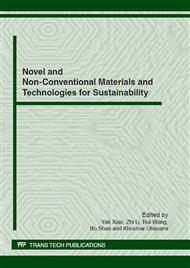[1]
Lopes, J. L. M. P; Bacarji, E; Figueiredo, Enio José Pazini; RÊGO, João Henrique da Silva. Influence of the marble and granite beneficiation of residue (MGBR) as filler on the properties of concrete. In: Enio Pazini Figueiredo; Terence Holland; Mohan Malhotra; Paulo Helene. (Org. ). ACI SP-253: Fifth International ACI/CANMET Conference on High Performance Concrete Structures and Materials. 1ª ed. Farmington Hills, Michigan: American Concrete Institute, 2008, v. SP-253, pp.341-362.
DOI: 10.14359/20184
Google Scholar
[2]
Gomes, K.A.E. S; Bacarji, E. Avaliação da influência da utilização do resíduo de beneficiamento de mármore e granito (RBMG) substituindo o agregado miúdo na produção de concretos. In: 50º Congresso Brasileiro Do Concreto - IBRACON, 2008, Salvador. 50º Congresso Brasileiro Do Concreto - IBRACON, (2008).
DOI: 10.29327/140860.2020-1
Google Scholar
[3]
Gomes, K.A.E. S; Bacarji, E. Avaliação do Módulo de Deformação e da durabilidade de concretos produzidos com o resíduo de beneficiamento de mármore e granito (RBMG) em substituição ao agregado miúdo. In: 51º IBRACON, 2009, Curitiba. 51º Congresso Brasileiro do Concreto, (2009).
DOI: 10.4322/2175-8182.62cbc009
Google Scholar
[4]
Nishikawa, K; Misugushi, H; Hashimoto, C; Tsutsui, H. Mechanical properties of self-compaction concrete using recycled material from demolished concrete structure as aggregate and powder. 5th International RILEM Symposium on Self-Compacting Concrete. RILEM Publications S.A.R.L. 2007, v. 2, pp.887-892.
DOI: 10.1007/978-3-319-03245-0_4
Google Scholar
[5]
Kou, S.C., Poon, C.S. Properties of self-compacting concrete prepared with recycled glass aggregate. Cement & Concrete Composites, v. 31, pp.107-113. (2009).
DOI: 10.1016/j.cemconcomp.2008.12.002
Google Scholar
[6]
Bacarji, E; Marques, V. C; Toledo Filho, R.D. Rheology and Mechanical Properties of Self-Compacting Concrete Containing Mineral Waste. In: IX Simposio Internacional de Estructuras, Geotecnia y Materiales de Construcción, Santa Clara - Cuba, (2010).
Google Scholar
[7]
Helene, P; Terzian, P. Manual de dosagem e controle do concreto. Pini. São Paulo. (1992).
Google Scholar
[8]
Tutikian, B.F. Método para dosagem de concretos auto adensáveis. 2004. 149p. Dissertação de mestrado. –Universidade Federal do Rio Grande do Sul. Porto Alegre.
DOI: 10.29289/259453942018v28s1059
Google Scholar
[9]
ABNT NBR 15823-2. Self Compacting Concrete Part 2: Slump flow test and flow time – Abrams cone method. Brazilian standards. (2010).
Google Scholar
[10]
ABNT NBR 15823-5. Self Compacting Concrete Part 5: Determination of the viscosity – V-funnel test. Brazilian standards. (2010).
Google Scholar
[11]
ABNT NBR 15823-4. Self Compacting Concrete Part4: Determination of passing ability – L-box method. Brazilian standards. (2010).
Google Scholar
[12]
ABNT NBR 15823-2. Self Compacting Concrete Part 6: Determination of the segregation resistance – Column segregation test. Brazilian standards. (2010).
Google Scholar
[13]
Monteiro, P.J.M.; Helene, P.R.L.; Kank, S.H. Designing concrete mixtures for strength, elastic modulus and fracture energy. Mater. Struct. 1993; 26: 443-452.
DOI: 10.1007/bf02472804
Google Scholar
[14]
ALYAMAÇ, E.K.; INCE, R.; A preliminary concrete mix design for SCC with marble powders. Construction and Building Materials. 2009; 23: 1201-1210.
DOI: 10.1016/j.conbuildmat.2008.08.012
Google Scholar
[15]
ABNT NBR 15823-1. Self Compacting Concrete Part 1: Classification, control and acceptance in the fresh state. Brazilian standards. (2010).
Google Scholar
[16]
Ferraris, C.F.; De Larrard, F. Testing and modeling of fresh concrete rheology. NISTIR 6094, Feb. (1998).
Google Scholar
[17]
Marangon, E.; Toledo Filho, R.D. Comportamento Reológico de Concretos Auto-Adensáveis Reforçados com Elevadas Frações Volumétricas de Fibras de Aço. In: BAC- Betão Auto Compactável - Segundo Congresso Iberico, 2010, Guimaraes. BAC, (2010).
DOI: 10.11606/t.18.2006.tde-28112006-171927
Google Scholar


